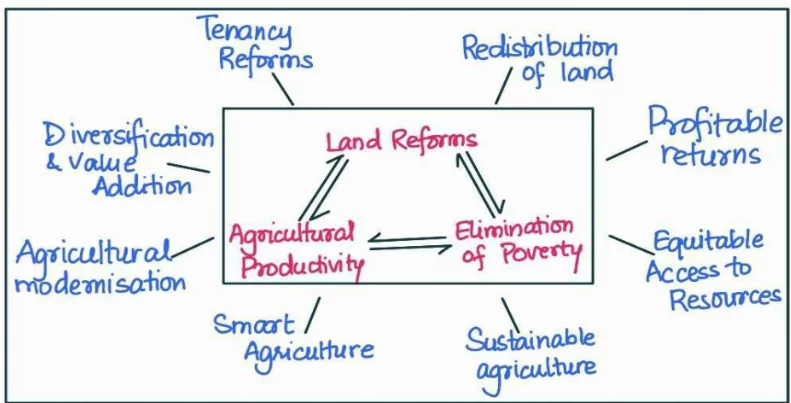Answer:
|
How to approach the question
- Introduction
- Write about land reforms briefly
- Body
- Write the relationship between land reform, agriculture productivity and elimination of poverty.
- Suggest the innovative strategies to implement land reforms for transforming the agricultural sector and alleviating poverty.
- Conclusion
- Give appropriate conclusion in this regard.
|
Introduction
Land reforms refer to a set of policies and measures aimed at redistributing land ownership, improving land tenure security, enhancing agricultural productivity, and promoting social justice and economic development in the agricultural sector. Example- Zamindari abolition and land to tillers in India.

Body
Relationship between land reform, agriculture productivity and elimination of poverty
- Redistribution of land: By providing landless farmers with productive assets. The Operation Barga initiative in West Bengal redistributed land to landless farmers, leading to increased agricultural productivity.
- Access to resources: For example, in the state of Kerala, land reforms resulted in the formation of cooperatives that provided farmers with improved access to credit, leading to increased productivity and poverty alleviation.
- Agricultural modernization: By the adoption of modern agricultural practices, technology, and machinery. In Punjab, land reforms in the 1960s and 1970s facilitated the Green Revolution, transforming the region into a prosperous agricultural hub.
- Tenancy reforms: As seen in Odisha, implementation of tenancy reforms improved productivity as tenants gained the motivation to invest in land improvement and agricultural practices.
- Diversification and value addition: As they encourage farmers to diversify their agricultural activities. In Himachal Pradesh, land reforms facilitated the shift from traditional crops to horticulture, leading to higher incomes and poverty reduction.
- Sustainable agriculture: Land reforms can promote sustainable agricultural practices, including organic farming and conservation techniques, leading to higher productivity and poverty reduction.
- Equitable Access to Resources: Land reform can promote equitable access to resources like land, water, and credit. Historically, land ownership disparities have led to the concentration of resources in the hands of a few wealthy landowners. By redistributing land, land reform ensures that more individuals have access to productive resources.
Innovative strategies to implement land reforms:
- Establishing Land Banks: Create a centralized institution like the Kerala Land Bank project that identifies and procures unutilized or underutilized land and redistributes it to landless farmers.
- Leasehold Farming: This would enable landless farmers to access productive land. As done under the Bhoomiheen Kisan program in Madhya Pradesh, where landless farmers are given long-term leases of government land.
- Joint Farming Ventures: This strategy encourages collaboration, economies of scale, and knowledge sharing among farmers. The Amul Dairy Cooperative in Gujarat, where farmers jointly manage the entire dairy value chain exemplifies this.
- Digital Land Records: To ensure transparency and prevent land disputes. The Bhulekh project in Odisha is an example where digitizing land records streamlined land administration. Another example is the Bhoomi Project of Karnatka.
- Land Consolidation: Facilitate land consolidation by encouraging landowners to voluntarily exchange or sell fragmented land parcels. The National Land Parcelization Project can be launched to consolidate small landholdings into larger plots.
- Contract Farming: Encouraging farmers to enter into agreements with agribusiness companies for assured markets and technical support. Learning from PepsiCo India’s successful contract farming initiatives for horticulture crops like potatoes.
Conclusion
Thus, there is an urgent need for implementing these innovative strategies that would contribute to transforming the agricultural sector in India, promoting equitable land distribution, improving agricultural productivity, and ultimately alleviating poverty among rural communities.
To get PDF version, Please click on "Print PDF" button.


Latest Comments